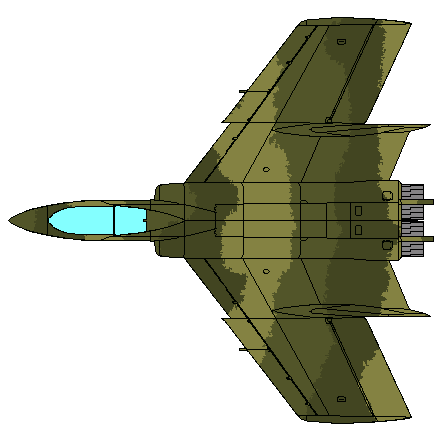Designation:F-72 Cutlass (A,C,E) Fighter |
|
||||

|
|||||
|
|
|||||
| Total Length: | 12.06m |
| Total Height: | 3.60m |
| Total Wingspan: | 11.78m |
| Dry Weight | 7,620kg |
The armor on the Cutlass is the current state-of-the-art development in low-mass composite-materials Chobham plating that became the standard for all Terran mecha after its application to the VQ-6A Vandal. Aside from the respectable protection provided against projectiles, missiles, and other kinetic weapons, this armor is also resistant to plasma globes (annihilation discs), lasers, and to a lesser extent, particle guns, owing to the fact that the armor can flake off and evaporate in layers under fire from such high-energy weapons, taking much of the weapon's energy and converting it into the latent heat of sublimation in the armor.
The armor stops all small arms fire, heavy infantry weapons fire, and light mecha-mounted weaponry; provides fair resistance to medium mecha-mounted weaponry, such as the Valkyrie's 55mm APFSDS round, and none to poor resistance to heavy mecha-mounted weaponry, such as the VHT's 105mm smoothbore shells.
The F-72 life support system provides full protection from nuclear, biological, and chemical hazards, using an overpressure cockpit environment activated by radiation and hazardous chemical sensors, or manually when such warfare conditions are anticipated. The internal consumables supplies can provide atmosphere for 36 hours maximum.
During the Republican Revolution, the Republican forces made several attempts to procure aircraft for its air forces and as spaceborne fighters. One of the less successful endeavors was the F-72 Cutlass. Derived from a design dating to the early Cold War of pre-Robotech times, the Cutlass in its original incantation was a marked failure, one of its chief weaknesses being its tendency to crash (chiefly but not exclusively thanks to innovative but faulty forward landing gear).
Precisely why the Republic of early days decided to copy this aircraft is not well understood, but one likely reason is desperation; as an aircraft shortage occurred in the early Revolution that was chiefly rectified by the introduction of the F-40 Skyray II. Republican planners were concerned that interruption in their supply of aircraft could prove fatal to the Revolution, or at least delay their objectives. It was decided that a new fighter, capable of serving in either a planetary air force or a spacefaring navy could help to prevent such an occurrence.
Republican officials again searched the Luna War Museum for imitable designs that could be improved upon and pressed into service. The F7U-1 Cutlass, originally manufactured by Chance Vought, was selected for the project. As done with the Skyray II, Teledyne Continental was asked to produce the new craft. Their engineers went through the same process, albeit doing minimal redesign work to the airframe. The most visible change was the use of a newer turbine of greater size than the original power plant, requiring a new rear centerbody arrangement. The craft was less armored than the Skyray II, in order to decrease cost. The rationale for doing so was the potential for fielding more aircraft; however, the Skyray was already well-armored and inexpensive enough to mass-produce in the same manner.
As less modification was necessary to bring the craft into production, far less time was needed to progress from prototype to production models. In July 2060, the first aircraft began to arrive at Republican bases, slowly equipping squadrons desperate for aircraft. Fewer Cutlass aircraft were manufactured than either Vipers for the Air Corps, or Skyrays for the Navy; thus rendering the supposed advantage a moot point. Most Republican commanders felt that the Cutlass aircraft was being pushed on them and preferred to keep them in reserve. As a result, the Cutlass saw less combat than expected and its effectiveness was never accurately determined. The most action Cutlass squadrons saw was in the final space combat against the Establishment fleet. Those pilots who flew the craft for any length of time eventually learned to dislike the fighter, although as an Air Corps craft it did gain a minor following due to its high maneuverability.
Crashes were still common and a number of pilots' lives were claimed by the Cutlass' tendency to roll over upon landing in an atmosphere. Despite this, it remained in service as it was an overall capable fighter. Its shortcomings were revealed in the press of combat in the early war with Tirol; combat persistence equal to the Skyray and Viper, but inferior survivability. Cannon firepower was potentially superior, mounting twice the EP-4 series cannons as either service-exclusive fighter, but in practice, combat required more power than the Protoculture energizer could supply at maximum output and rate of fire was often reduced to 75% of max or less. For these reasons, it was slowly drawn out of service in 2064. Due to a lack of capable electronic warfare craft, the Cutlass E version remained in service for two more years, with a small number of retired fighters rebuilt to E specification.
Return to Republic Combat Aircraft Index
Return to Robotech Republican Compendium Home Page
Robotech (R) is the property of Harmony Gold. This document is in no way intended to infringe upon their rights.
Content by Derek Ralph